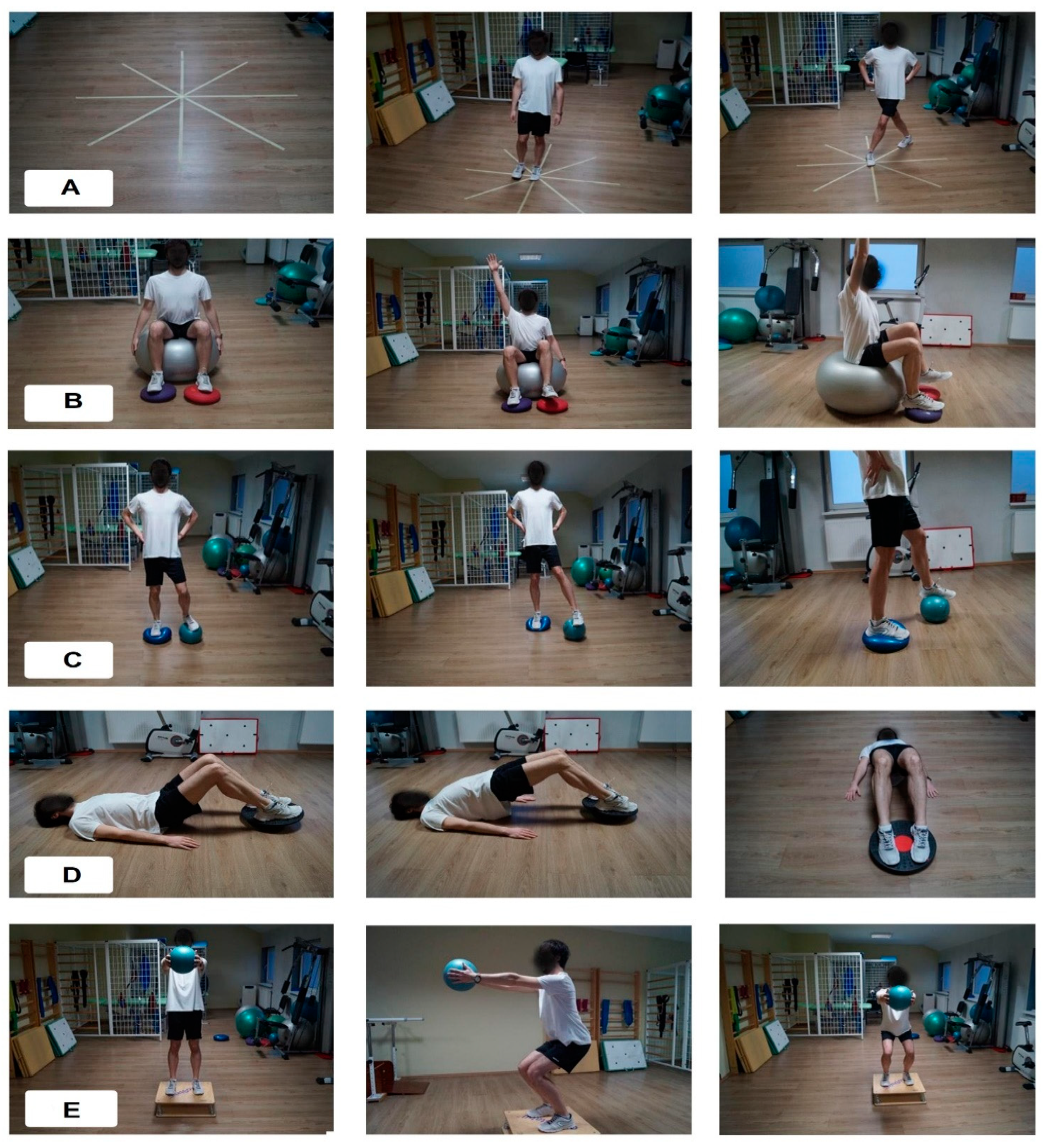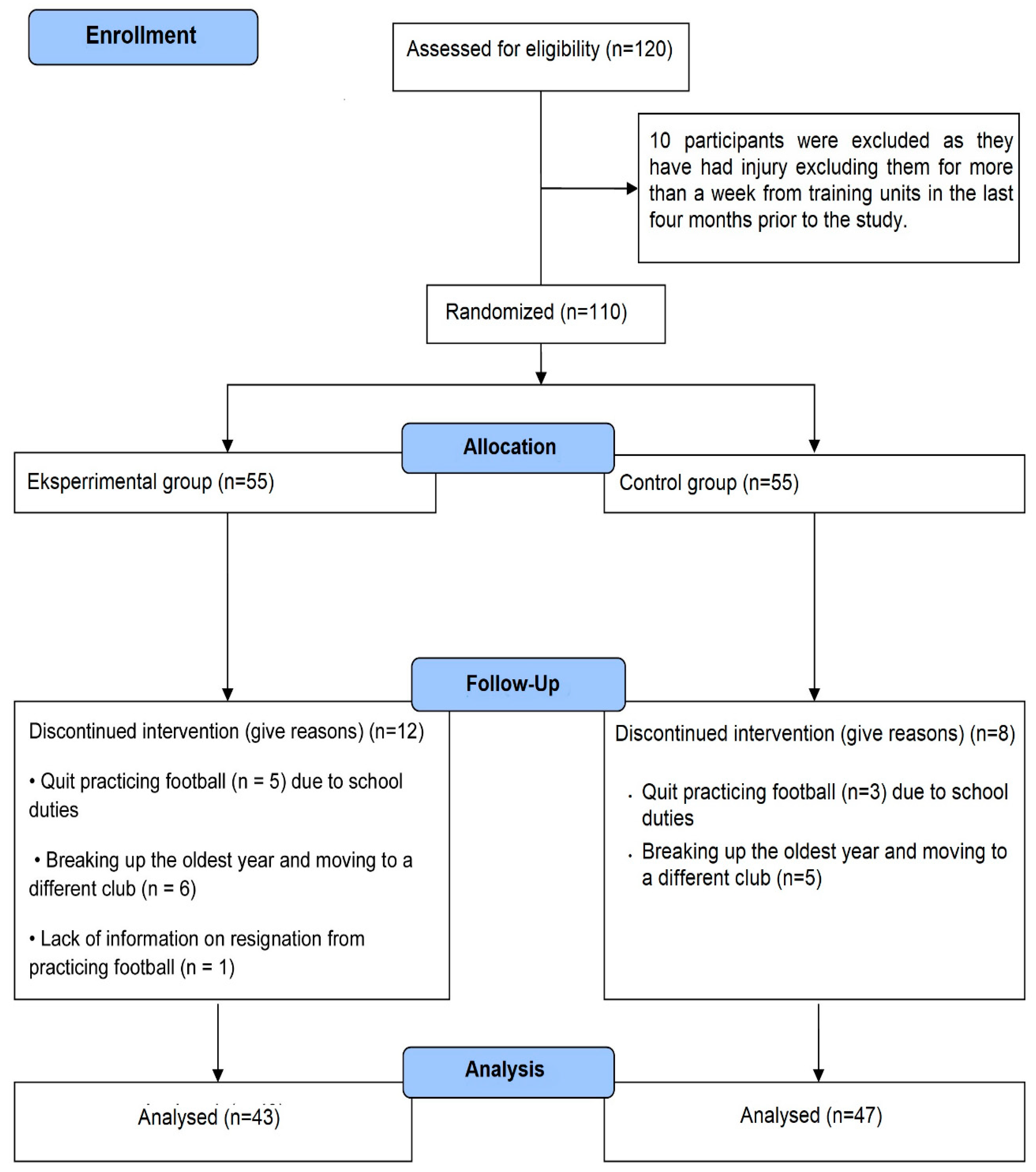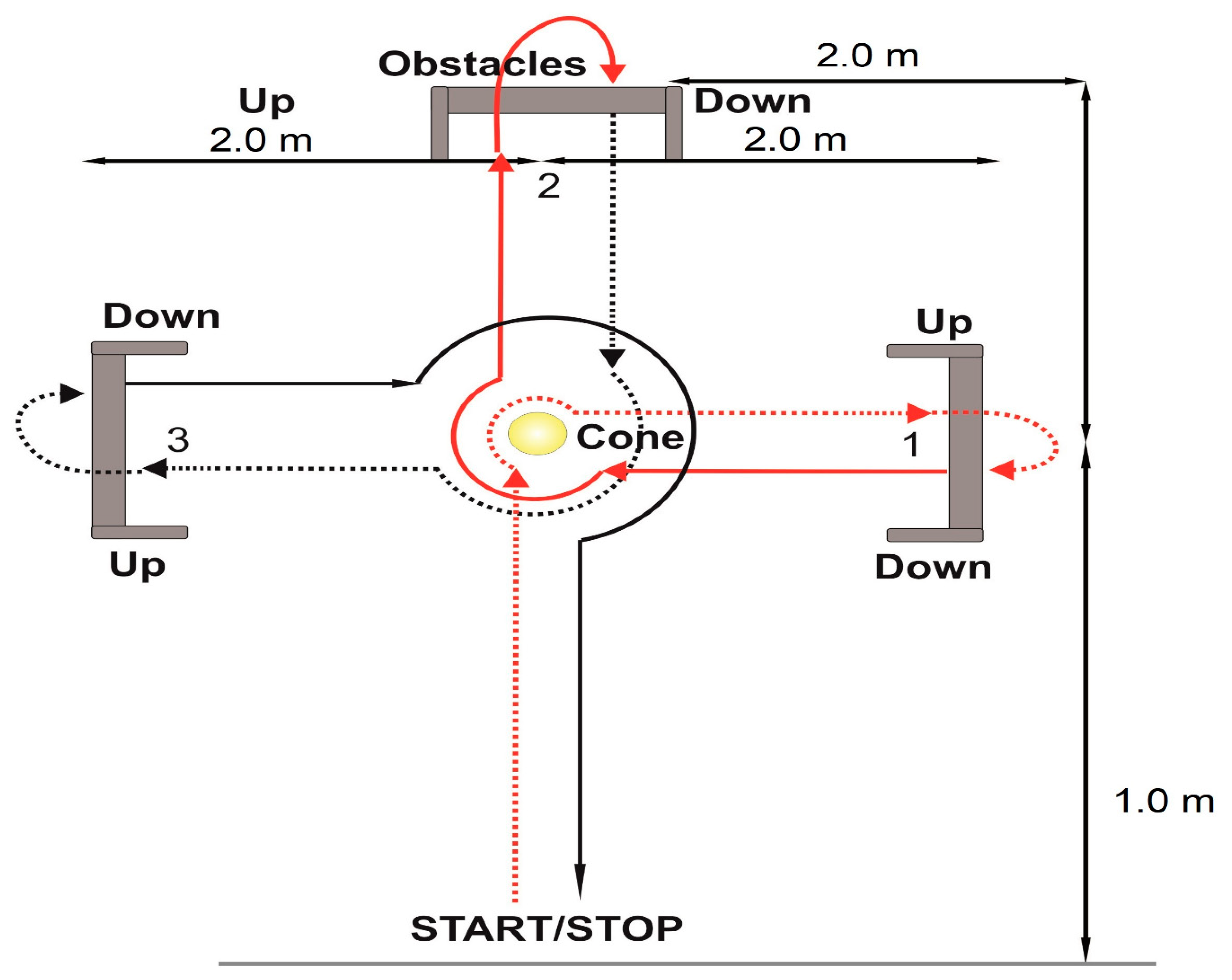Effect of a 10-Week Sensomotor Exercise Program on Balance and Agility in Adolescent Football Players: A Randomised Control Trial
Abstract
1. Introduction
2. Materials and Methods
2.1. Ethics
2.2. Study Design
2.3. Participants
2.4. Randomisation and Allocation
2.5. Blinding Procedures
2.6. Outcome Measures
2.6.1. Y Balance Test (Y-BT)
2.6.2. Stabilometric Platform—ALFA
2.6.3. Agility Test
2.7. Intervention
- (1)
- First exercise—“star” (Figure 4A):
- (2)
- Second exercise—alternate lifting of upper and lower limbs while sitting on a Swedish ball (Figure 4B):
- (3)
- Third exercise—rolling a ball around a sensory disc (Figure 4C):
- (4)
- Fourth exercise—tilting with feet on the Domyos (Figure 4D):
- (5)
- Fifth exercise—squats with a ball on the ortho-stable platform (Figure 4E):

2.8. Statistical Analysis
3. Results
3.1. Participants
3.2. Stabilometric Platform
3.3. Y-BT
3.4. Agility Test
4. Discussion
5. Conclusions
Author Contributions
Funding
Institutional Review Board Statement
Informed Consent Statement
Data Availability Statement
Acknowledgments
Conflicts of Interest
References
- Ricotti, L. Static and dynamic balance in young athletes. J. Hum. Sport Exerc. 2012, 6, 616–628. [Google Scholar] [CrossRef]
- Schedler, S.; Brock, K.; Fleischhauer, F.; Kiss, R.; Muehlbauer, T. Effects of balance training on balance performance in youth: Are there age differences? Res. Q. Exerc. Sport. 2020, 6, 405–414. [Google Scholar] [CrossRef]
- Weineck, J. Optimales Training; Verlag GmbH: Balingen, German, 2001. [Google Scholar]
- Payne, G.; Isaacs, L. Human Motor Development: A Lifespan Approach; McGraw-Hill: New York, NY, USA, 2012. [Google Scholar]
- Eisemann, J.C.; Malina, R.M. Age- and sex-associated variation in neuromuscular capacities of adolescent distance runners. J. Sports Sci. 2003, 21, 551–557. [Google Scholar] [CrossRef] [PubMed]
- Makhlouf, I.; Chaouachi, A.; Chaouachi, M.; Othman, A.B.; Granacher, U.; Behm, D.G. Combination of agility and plyometric training provides similar training benefits as combined balance and plyometric training in young soccer players. Front. Physiol. 2018, 9, 01611. [Google Scholar] [CrossRef]
- Bruhn, S.; Kullmann, N.; Gollhofer, A. The effects of a sensorimotor training and a strength training on postural stabilisation, maximum isometric contraction and jump performance. Int. J. Sports Med. 2004, 25, 56–60. [Google Scholar] [CrossRef] [PubMed]
- Caldemeyer, L.E.; Brown, S.M.; Mulcahey, M.K. Neuromuscular training for the prevention of ankle sprains in female athletes: A systematic review. Phys. Sportsmed. 2020, 28, 363–369. [Google Scholar] [CrossRef] [PubMed]
- Heleno, L.R.; Da Silva, R.A.; Shigaki, L.; Araújo, C.G.; Candido, C.R.; Okazaki, V.H.; Frisseli, A.; Macedo, C.G. Five-week sensory motor training program improves functional performance and postural control in young male soccer players—A blind randomized clinical trial. Phys. Ther. Sport. 2016, 22, 74–80. [Google Scholar] [CrossRef]
- McGuine, T.A.; Greene, J.J.; Best, T.; Leverson, G. Balance as a predictor of ankle injuries in high school basketball players. Clin. J. Sport Med. 2000, 10, 239–244. [Google Scholar] [CrossRef]
- Adlerton, A.K.; Moritz, U.; Moe-Nilssen, R. Forceplate and accelerometer measures for evaluating the effect of muscle fatigue on postural control during one-legged stance. Physiother. Res. Int. 2003, 8, 187–199. [Google Scholar] [CrossRef]
- Hrysomallis, C. Balance ability and athletic performance. Sport. Med. 2011, 41, 221–232. [Google Scholar] [CrossRef]
- Mandelbaum, B.R.; Silvers, H.J.; Watanabe, D.S.; Knarr, J.F.; Thomas, S.D.; Griffin, L.Y.; Kirkendall, D.T.; Garett, W.J. Effectiveness of a neuromuscular and proprioceptive training program in preventing the incidence of anterior cruciate ligament injuries in female athletes: 2-year follow up. Am. J. Sports Med. 2005, 33, 1003–1010. [Google Scholar] [CrossRef] [PubMed]
- Rivera, M.J.; Winkelmann, Z.K.; Powden, C.J.; Games, K.E. Proprioceptive Training for the Prevention of Ankle Sprains: An Evidence-Based Review. J. Athl. Train. 2017, 52, 1065–1067. [Google Scholar] [CrossRef] [PubMed]
- Zech, A.; Klahn, P.; Hoeft, J.; Eulenburg, C.; Steib, S. Time course and dimensions of postural control changes following neuromuscular training in youth field hockey athletes. Eur. J. Appl. Physiol. 2014, 114, 395–403. [Google Scholar] [CrossRef] [PubMed]
- Barber-Westin, S.D.; Hermeto, A.A.; Noyes, F.R. A six-week neuromuscular training program for competitive junior tennis players. J. Strength Cond. Res. 2010, 24, 2372–2382. [Google Scholar] [CrossRef]
- Kang, S.H.; Kim, C.W.; Kim, Y.I.L.; Kim, K.; Lee, S.S.; Shin, K. Alterations of muscular strength and left and right limb balance in weightlifters after an 8-week balance training program. J. Phys. Ther. Sci. 2013, 25, 895–900. [Google Scholar] [CrossRef]
- Verhagen, E.; Bobbert, M.; Inklaar, M.; Kalken, M.; Beek, A.; Bouter, L.; Mechelen, W. The effect of a balance training programme on centre of pressure excursion in one-leg stance. Clin. Biomech. 2005, 20, 1094–1100. [Google Scholar] [CrossRef]
- Kachanathu, S.; Tyagi, P.; Anand, P.; Hameed, U.A.; Algarni, A.D. Effect of core stabilization training on dynamic balance in professional soccer players. Phys. Medizin. Rehabil. Kurortmed. 2014, 24, 299–304. [Google Scholar] [CrossRef]
- Bagherian, S.; Ghasempoor, K.; Rahnama, N.; Wikstrom, E.A. The Effect of Core Stability Training on Functional Movement Patterns in College Athletes. J. Sport. Rehabil. 2019, 1, 444–449. [Google Scholar] [CrossRef]
- Janda, V. Muscles and Motor Control in Low Back Pain: Assessment and Management. In Physical Therapy of the Low Back; Twomey, L.T., Ed.; Churchill Livingstone: New York, NY, USA, 1987; pp. 253–278. [Google Scholar]
- Page, P. Sensorimotor training: A “global” approach for balance training. J. Bodyw. Move Therap. 2006, 10, 77–84. [Google Scholar] [CrossRef]
- Ter Stege, M.H.; Dallinga, J.M.; Benjaminse, A.; Lemmink, K.A. Effect of interventions on potential, modifiable risk factors for knee injury in team ball sports: A systematic review. Sports Med. 2014, 44, 1403–1426. [Google Scholar] [CrossRef]
- Zebis, M.K.; Bencke, J.; Andersen, L.L.; Døssing, S.; Alkjær, T.; Magnusson, S.P.; Kjær, M.; Aagaard, P. The effects of neuromuscular training on knee joint motor control during sidecutting in female elite soccer and handball players. Clin. J. Sport Med. 2008, 18, 329–337. [Google Scholar] [CrossRef] [PubMed]
- Padua, D.A.; DiStefano, L.J.; Hewett, T.E.; Garrett, W.E.; Marshall, S.W.; Golden, G.M.; Shultz, S.J.; Sigward, S.M. National Athletic Trainers’ Association Position Statement: Prevention of Anterior Cruciate Ligament Injury. J. Athl. Train. 2018, 53, 5–19. [Google Scholar] [CrossRef] [PubMed]
- Ghaderi, M.; Letafatkar, A.; Thomas, A.C.; Keyhani, S. Effects of a neuromuscular training program using external focus attention cues in male athletes with anterior cruciate ligament reconstruction: A randomized clinical trial. BMC Sports. Sci. Med. Rehabil. 2021, 13, 49. [Google Scholar] [CrossRef] [PubMed]
- Saunders, N.W.; Hanson, N.J.; Koutakis, P.; Chaudhari, A.M.; Devor, S.T. Figure skater level moderates balance training. Int. J. Sports Med. 2013, 34, 345–349. [Google Scholar] [CrossRef] [PubMed]
- Brachman, A.; Kamieniarz, A.; Michalska, J.; Pawłowski, M.; Słomka, K.; Juras, G. Balance training programs in athletes—A systematic review. J. Hum. Kinet. 2017, 58, 45–64. [Google Scholar] [CrossRef] [PubMed]
- Clarsen, B.; Rønsen, O.; Myklebust, G.; Flørenes, T.W.; Bahr, R. The Oslo Sports Trauma Research Center que—Stionnaire on health problems: A new approach to prospective monitoring of illness and injury in elite athletes. Br. J. Sports Med. 2014, 48, 754–760. [Google Scholar] [CrossRef] [PubMed]
- Plisky, P.J.; Gorman, P.P.; Butler, R.J.; Kiesel, K.B.; Underwood, F.B.; Elkins, B. The reliability of an instrumented device for measuring components of the star excursion balance test. N. Am. J. Sports Phys. Ther. 2009, 4, 92–99. [Google Scholar]
- Linek, P.; Sikora, D.; Wolny, T.; Saulicz, E. Reliability and number of trials of Y Balance Test in adolescent athletes. Musculoskelet. Sci. Pract. 2017, 31, 72–75. [Google Scholar] [CrossRef]
- Alesi, M.; Bianco, A.; Padulo, J.; Luppina, G.; Petrucci, M.; Paoli, A.; Palma, A.; Pepi, A. Motor and cognitive growth following a football training program. Front. Psychol. 2015, 6, 1627. [Google Scholar] [CrossRef]
- Benis, R.; Bonato, M.; Torre, A. Elite female basketball players body-weight neuromuscular training and performance on the y-balance test. J. Athl. Train. 2016, 51, 688–695. [Google Scholar] [CrossRef]
- Alyson, F.; Byrnes, R.; Paterno, M.V.; Myer, G.D.; Hewett, T.E. Neuromuscular training improves performance on the star excursion balance test in young female athletes. J. Orthop. Sports Phys. Ther. 2010, 40, 551–558. [Google Scholar]
- Sato, K.; Mokha, M. Does core strength training influence running kinetics, lower-extremity stability and 5000-m performance in runners? J. Strength Cond. Res. 2009, 23, 133–140. [Google Scholar] [CrossRef] [PubMed]
- Hopkins, W.G.; Marshall, S.W.; Quarrie, K.L.; Hume, P. Risk Factors and Risk Statistics for Sports Injuries. Clin. J. Sport Med. 2007, 17, 208–210. [Google Scholar] [CrossRef]
- Whittaker, J.L.; Booysen, N.; De la Motte, S.; Dennett, L.; Lewis, C.L.; Wilson, D.; McKay, C.; Warner, M.; Padua, D.; Emery, C.A.; et al. Predicting sport and occupational lower extremity injury risk through movement quality screening: A systematic review. Br. J. Sports Med. 2017, 51, 580–585. [Google Scholar] [CrossRef] [PubMed]
- Imai, A.; Kaneoka, K.; Okubo, Y.; Shiraki, H. Effects of two types of trunk exercises on balance and athletic performance in youth soccer players. Int. J. Sports Phys. Ther. 2014, 9, 47–57. [Google Scholar] [PubMed]
- Gioftsidou, A.; Malliou, P.; Pafis, G.; Beneka, A.; Godolias, G.; Magnaris, C. The effects of soccer training and timing of balance training on balance ability. Eur. J. Appl. Physiol. 2006, 96, 659–664. [Google Scholar] [CrossRef]
- Pau, M.; Loi, A.; Pezzotta, M.C. Does sensorimotor training improve the static balance of young volleyball players? Sport Biomech. 2011, 11, 97–107. [Google Scholar] [CrossRef]
- Aagaard, P. Training-induced changes in neural function. Exerc. Sport Sci. Rev. 2003, 31, 61–67. [Google Scholar] [CrossRef]
- Low, D.C.; Walsh, G.S.; Arkesteijn, M. Effectiveness of Exercise Interventions to Improve Postural Control in Older Adults: A Systematic Review and Meta-Analyses of Centre of Pressure Measurements. Sports Med. 2017, 47, 101–112. [Google Scholar] [CrossRef]
- Rössler, R.; Donath, L.; Bizzini, M.; Faude, O. A new injury prevention programme for children’s football FIFA 11+ kids can improve motor performance: A cluster-randomised controlled trial. J. Sports Sci. 2016, 34, 549–556. [Google Scholar] [CrossRef]
- Zouhal, H.; Abderrahman, A.B.; Dupont, G.; Truptin, P.; Le Bris, R.; Le Postec, E.; Sghaeir, Z.; Brughelli, M.; Granacher, U.; Bideau, B. Effects of neuromuscular training on agility performance in elite soccer players. Front Physiol. 2019, 10, 947. [Google Scholar] [CrossRef]



| Experimental Group (n = 43) | Min. | Max. | Control Group (n = 47) | Min. | Max. | p-Value | |
|---|---|---|---|---|---|---|---|
| Age [years] | 12.5 ± 2.2 | 10.0 | 17.0 | 12.4 ± 2.1 | 10.0 | 17.0 | 0.8 |
| Weight [kg] | 44.4 ± 9.5 | 27.3 | 61.9 | 43.8 ± 12.4 | 26.3 | 78.1 | 0.8 |
| Height [cm] | 155.3 ± 11.5 | 135.0 | 176.0 | 155.8 ± 14.2 | 125.0 | 185.0 | 0.9 |
| BMI [kg/m2] | 18.2 ± 2.3 | 14.7 | 24.4 | 17.6 ± 2.5 | 13.6 | 24.9 | 0.3 |
| Years of training [years] | 4.9 ± 2.2 | 2.0 | 10.0 | 4.9 ± 1.9 | 2.0 | 9.0 | 0.9 |
| Number of training days per week [days] | 2.5 ± 0.5 | 2.0 | 3.0 | 2.5 ± 0.5 | 2.0 | 3.0 | 1.0 |
| Experimental Group (n = 43) | Control Group (n = 47) | Experimental Group Pre/Post Training p-Value | Control Group Pre/Post Training p-Value | Experimental/Control Group Pre-Training p-Value | Experimental /Control Group Post-Training p-Value | ||||
|---|---|---|---|---|---|---|---|---|---|
| Me ± SE | Q | Me ± SE | Q | ||||||
| Track Length— eyes open 30 s [cm] | Pre-training | 22.8 ± 0.4 | 16.3–30.0 | 25.4 ± 0.2 | 16.5–31.9 | 0.001 *** | 0.1 | 0.2 | 0.003 ** |
| Post-training | 15.8 ± 0.4 | 13.4–20.6 | 20.7 ± 0.2 | 16.5–26.4 | |||||
| Surface Area—eyes open 30 s [cm2] | Pre-training | 1.5 ± 0.2 | 0.8–2.9 | 1.4 ± 0.1 | 0.9–2.6 | 0.001 *** | 0.6 | 0.8 | 0.02 * |
| Post-training | 1.0 ± 0.1 | 0.7–1.7 | 1.6 ± 0.1 | 1.0–2.6 | |||||
| Track Length— eyes closed 30 s [cm] | Pre-training | 32.2 ± 0.5 | 22.6–43.5 | 33.1 ± 0.3 | 24.2–42.7 | 0.001 *** | 0.001 ** | 0.8 | 0.1 |
| Post-training | 24.9 ± 0.4 | 19.4–32.5 | 29.4 ± 0.3 | 22.4–38.7 | |||||
| Surface area—eyes closed 30 s [cm2] | Pre-training | 1.8 ± 0.3 | 1.2–3.0 | 2.1 ± 0.1 | 1.4–4.1 | 0.01 ** | 0.1 | 0.3 | 0.2 |
| Post-training | 1.7 ± 0.1 | 0.9–3.1 | 2.2 ± 0.1 | 1.3–3.9 | |||||
| Experimental Group(n = 43) | Control Group (n = 47) | Experimental Group Pre/Post Training p-Value | Control Group Pre/Post Training p-Value | Experimental /Control Group Pre-Training p-Value | Experimental /Control Group Post-Training p-Value | ||||
|---|---|---|---|---|---|---|---|---|---|
| Me ± SE | Q | Me ± SE | Q | ||||||
| Y-Anterior Right [%] | Pre-training | 72.5 ± 0.2 | 66.3–76.6 | 71.8 ± 0.1 | 67.9–75.6 | 0.5 | 0.6 | 0.7 | 0.5 |
| Post-training | 71.5 ± 0.2 | 69.5–76.4 | 71.2 ± 0.2 | 67.1–76.2 | |||||
| Y-Anterior Left [%] | Pre-training | 71.3 ± 0.1 | 65.7–76.5 | 70.9 ± 0.1 | 67.4–75.4 | 0.02 * | 0.2 | 0.9 | 0.04 * |
| Post-training | 72.6 ± 0.2 | 68.3–78.6 | 69.9 ± 0.2 | 65.9–75.2 | |||||
| Y- Posterolateral Right [%] | Pre-training | 109.9 ± 0.3 | 100.6–115.0 | 109.3 ± 0.3 | 102.0–114.7 | 0.01 * | 0.5 | 1.0 | 0.1 |
| Post-training | 111.2 ± 0.3 | 107.2–116.0 | 108.3 ± 0.3 | 102.1–114.8 | |||||
| Y- Posterolateral Left [%] | Pre-training | 108.6 ± 0.3 | 101.2–118.0 | 107.9 ± 0.2 | 102.8–113.2 | 0.1 | 0.8 | 0.6 | 0.3 |
| Post-training | 111.4 ± 0.3 | 104.6–115.6 | 108.6 ± 0.3 | 101.6–115.1 | |||||
| Y- Posteromedial Right [%] | Pre-training | 105.0 ± 0.3 | 99.6–113.5 | 107.1 ± 0.2 | 98.6–110.6 | 0.001 ** | 0.1 | 0.7 | 0.04 * |
| Post-training | 111.8 ± 0.3 | 107.0–116.1 | 107.3 ± 0.3 | 99.6–114.2 | |||||
| Y- Posteromedial Left [%] | Pre-training | 107.1 ± 0.2 | 99.6–112.9 | 106.4 ± 0.2 | 99.3–111.7 | 0.0001 *** | 0.1 | 0.7 | 0.001 ** |
| Post-training | 110.3 ± 0.3 | 108.1–116.7 | 108.5 ± 0.3 | 100.6–114.2 | |||||
| Y-Anterior—Medium [%] | Pre-training | 71.7 ± 0.1 | 66.2–75.5 | 71.3 ± 0.1 | 67.6–75.1 | 0.4 | 0.2 | 0.7 | 0.2 |
| Post-training | 72.0 ± 0.2 | 68.4–76.2 | 70.8 ± 0.2 | 67.0–74.5 | |||||
| Y- Posterolateral Medium [%] | Pre-training | 109.2 ± 0.2 | 102.8–113.4 | 107.9 ± 0.2 | 101.8–113.5 | 0.02 * | 0.8 | 0.8 | 0.2 |
| Post-training | 110.1 ± 0.2 | 106.0–115.8 | 108.4 ± 0.3 | 102.2–114.8 | |||||
| Y- Posteromedial Medium [%] | Pre-training | 106.7 ± 0.2 | 99.4–113.1 | 105.4 ± 0.2 | 98.5–110.6 | 0.0001 *** | 0.03 * | 0.6 | 0.02 * |
| Post-training | 111.6 ± 0.2 | 106.1–116.9 | 106.6 ± 0.3 | 99.5–113.9 | |||||
| Y-Total Score [%] | Pre-training | 95.9 ± 0.2 | 89.9–101.5 | 94.8 ± 0.2 | 91.3–98.9 | 0.0003 *** | 0.3 | 0.7 | 0.04 * |
| Post-training | 98.3 ± 0.2 | 94.7–101.6 | 95.4 ± 0.2 | 88.9–100.9 | |||||
| Experimental Group (n = 43) | Control Group (n = 47) | Experimental Group Pre/Post Training p-Value | Control Group Pre/Post Training p-Value | Experimental /Control Group Pre-Training p-Value | Experimental/Control Group Post-Training p-Value | ||||
|---|---|---|---|---|---|---|---|---|---|
| Me ± SE | Q | Me ± SE | Q | ||||||
| Agility test (s) | Pre-training | 14.2 ± 0.1 | 13.5–16.6 | 14.4 ± 0.1 | 13.2–15.5 | 0.001 *** | 0.2 | 0.7 | 0.04 * |
| Post-training | 13.0 ± 0.1 | 11.5–15.2 | 14.2 ± 0.1 | 12.5–15.3 | |||||
Disclaimer/Publisher’s Note: The statements, opinions and data contained in all publications are solely those of the individual author(s) and contributor(s) and not of MDPI and/or the editor(s). MDPI and/or the editor(s) disclaim responsibility for any injury to people or property resulting from any ideas, methods, instructions or products referred to in the content. |
© 2022 by the authors. Licensee MDPI, Basel, Switzerland. This article is an open access article distributed under the terms and conditions of the Creative Commons Attribution (CC BY) license (https://creativecommons.org/licenses/by/4.0/).
Share and Cite
Sikora, D.; Linek, P. Effect of a 10-Week Sensomotor Exercise Program on Balance and Agility in Adolescent Football Players: A Randomised Control Trial. Appl. Sci. 2023, 13, 89. https://doi.org/10.3390/app13010089
Sikora D, Linek P. Effect of a 10-Week Sensomotor Exercise Program on Balance and Agility in Adolescent Football Players: A Randomised Control Trial. Applied Sciences. 2023; 13(1):89. https://doi.org/10.3390/app13010089
Chicago/Turabian StyleSikora, Damian, and Pawel Linek. 2023. "Effect of a 10-Week Sensomotor Exercise Program on Balance and Agility in Adolescent Football Players: A Randomised Control Trial" Applied Sciences 13, no. 1: 89. https://doi.org/10.3390/app13010089
APA StyleSikora, D., & Linek, P. (2023). Effect of a 10-Week Sensomotor Exercise Program on Balance and Agility in Adolescent Football Players: A Randomised Control Trial. Applied Sciences, 13(1), 89. https://doi.org/10.3390/app13010089






